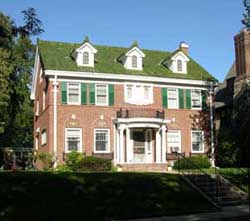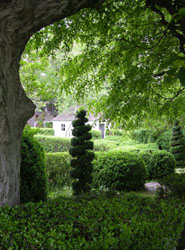Georgian House Style
- Formal, parterre and transition garden style
This period corresponds to the reigns of George I to George IV in England. Architecture is based on the style called ‘Palladian’, after the Italian architect, Andrea Palladio. The Palladian style is an attempt to recreate the classical style of Rome, circa 27 CE -14 CE. Monticello is an excellent example of the architectural style, although the gardens are in the later Romantic English Landscape style. Architecture
 | Fig. 7 |
Garden plan
 | Fig. 8 |
Water features, paths and fences
Common water features are a square or round lily pond or formal fountain edged in box, while paths are varied. Gravel, and crushed sea shells, and square-cut flagstones are joined, after the Revolution, by brick, which no longer needs to be imported from England. Paths in the sometimes terraced ‘working’ (vegetable) gardens are grass. The main driveway is lined by an allee of trees. Brick garden walls match the brick in the house, but stone and wood are also still used.
Vegetable gardens
The vegetable gardens at Monticello are a well-documented model of the times. Jefferson purchases common vegetables from slave gardens and plants more exotic or varied cultivars in his own garden, such as artichokes, eggplant, endive, peppers, and white and yellow squash.
Flowers, shrubs, trees
Newly discovered native species such as snowberry bush and flowering currant, are added to the plant palette by the Lewis and Clark expedition (1804-06) commissioned by Thomas Jefferson. Other new favorites are the Virginia bluebell, umbrella magnolia, and catalpa. The Monticello gardens are an excellent seed source for vegetables and flowers.
Fruit trees, bushes
Fruit trees, including some native crab apples, are often planted from seed producing an uneven quality. But this is of small consequence as most apples are made into cider and peaches are made into brandy. It is some time before Americans eat their fruit rather than drinking it. However, some of the trees grown from seed become favorites and are later grafted or budded for consistency.
